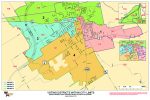Chisholm Trail beginnings: Tough days but better pay
By Kyle Mooty
LPR Editor
Thanks to the Civil War, the Chisholm Trail, as well as other cattle drives were born.
Looking to get a far better profit for their beef cattle, Lockhart cattle owners decided to traverse hundreds of miles of rough terrain, tough inclement weather conditions, and hostile Indians as they pushed their herd north to Abilene, Kansas, where they could fetch 10 times per head ($40) of what they were making in this area ($4).
The Chisholm Trail was named after Cherokee merchant Jesse Chisholm, who owned trading posts along the trail). Lockhart played an integral part in these drives, including more than 50 trail drivers coming from here. Among those, according to Ronda Reagan’s book “Images of America… Lockhart,” were Col. J.J. Meyers, Sam Garner, Mark Withers, Andrew Lee Brock, Noah Ellis, Jesse Blackwell, J.M. Jones, A.M. Cardwell, and Berry Robuck.
In 1860, there were six times more cattle in Texas than people, but the market was practically bare because of the Civil War, a.k.a. The War Between the States. The Union Army of the North controlled the Mississippi River and maintained the blockade in the Gulf, making it impossible for Texans to supply beef to the Confederate Army and northern markets. This birthed the idea of driving herds north to Kansas and Missouri from Lockhart.
The drives lasted from 1866-1895.
Lockhart resident Col. J.J. Meyers made the first drive from Lockhart after striking a deal with Joseph McCoy, who had stockyards in Kansas. The drive would take as long as seven months.
According to Reagan’s book, one of Lockhart‘s most colorful cowboys was Sam Roberson Garner. He drove cattle up Chisholm Trail from 1869 to 1882. Born in Tennessee in 1847, Garner joined the Confederate Army at the age of 16, eventually moving to Texas where he built a home on Tinney Creek, nine miles east of Lockhart, in 1873.
Garner’s home still stands today. Garner married Mary Lucinda Halsell and they raised 11 children. Garner would live in Caldwell County until passing away in 1924. He is buried at the Jeffrey cemetery.
The largest herd that came through Lockhart had about 16,000 head of cattle after two trail drives converged. Reagan’s book said it was not uncommon for cattle come through the town square, kicking up a dusty trail and trampling local fences and gardens before they headed out of town. About 10 million head of cattle were driven out of Texas to fetch higher prices elsewhere, representing the greatest migration of domestic animals in world history.
Trail-driving ended with the advancement of the railroad, so by 1900 cotton was king in Lockhart. Farming and growing crops would become one of Lockhart’s leading commercial agribusinesses. Today, Texas is still the nation’s leader in livestock production.
Today, including this week with a three-day event in Lockhart, the Chisholm Trail Roundup is still remembered.





Very good article! I’m a decedent of Sam Garner and would love any more information you have that includes him. Jesse Blackwell was a close friend of the family. Close enough that my mother and her sister referred to him as uncle Jess.
My mom it still alive, 89 and I will read this article to her, as I know she will enjoy it immensely.
Anything you could share with me would be greatly appreciated